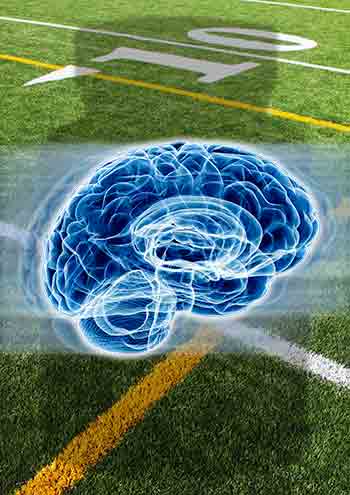A wide receiver is tackled after catching a pass in a game of football. He hits the ground hard and his brain is jolted from the momentum. The athlete experiences dizziness, nausea, and ringing in his ears and is diagnosed with a concussion. When can he return to the field?
New Penn State research suggests genetics plays a major role in determining how quickly a concussed athlete recovers. Peter Arnett, professor of psychology and director of clinical training at Penn State, has observed hundreds of concussed athletes in his lab over the last ten years and often wondered why some athletes would recover more rapidly than others. He led a team of researchers to find out, and their work was recently published in the Journal of the International Neuropsychological Society.
According to Arnett, while the relationship between genetic factors and outcomes after brain injury is beginning to receive more attention recently, little study has been devoted to specific genes and their effects on concussion recovery. “We wanted to determine how the apolipoprotein E (APOE) gene influences symptoms following a sports-relation concussion.”
Arnett and his research team studied 42 collegiate athletes who completed concussion testing within three months of their injury. All the participants in the study sustained a mild concussion, as determined by their team physicians, and underwent testing as soon as possible following the injury.
The athletes also provided buccal swabs taken from the insides of their cheeks to provide DNA samples for analysis at Penn State’s Genomics Core Facility to determine the make-up of their APOE genotype.
According to Arnett, there are three different versions (alleles) of the APOE gene. “The major alleles are called e2, e3, and e4. For this study, we focused on the e4 allele and how it influences concussion symptoms, as it is associated with unfavorable outcomes following brain injury.” The presence of the e4 allele also increases a person’s risk for developing Alzheimer’s disease.
Arnett determined that approximately 30 percent of the athletes he tested had the e4 allele. “I was a bit surprised by the high percentage, as we approximate 20 to 25 percent of the general population has the e4 allele.” His team compared concussed athletes with the e4 allele to those without it, and found athletes with the e4 allele scored higher on the Post Concussion Symptom Scale (PCSS).
The PCSS, administered through the ImPACT computer program, surveys symptoms such as dizziness, headaches, nausea and other commonly experienced post-concussion symptoms to determine their severity. “Athletes were able to rate their current symptoms from zero — representing no symptoms, to six — representing severe symptoms,” said Victoria Merritt, a doctoral candidate in Arnett’s lab and lead author on the study. “Athletes with the e4 allele reported greater physical and cognitive symptoms than athletes without it.” Merritt said they compared the findings to her previous work on symptom clusters, and determined physical and cognitive clusters were most affected by a concussion injury.
According to Arnett, this is the first study to examine and establish a relationship between the e4 allele and post-concussion-symptom reporting patterns among concussed collegiate athletes. “Our results overwhelmingly indicate that e4 positive participants may be at a greater risk for experiencing post-concussion symptoms.”
Arnett and Merritt plan to expand upon their findings in a new study focusing on middle and high school students. In the future, they hope their research findings will be useful in screening athletes as well as military personnel who experience blast-related brain injuries in combat.
The research team also included Deborah Grove, director of Penn State’s Genomics Core Facility. The project was supported by Penn State Sports Medicine and the American Psychological Foundation.



The co occurring of the dental bite and temporal mandibular joint position, according to research, must be properly aligned. While in many cases, genetics is related to poor orthodontics, jaw issues. Ignoring this mechanism directly related to neck strength musculature in research is a major pit fall to NFL research. http://www.shockdoctorppm.com